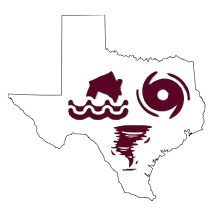Common Myths and Reasons To Prepare
“I survived the last hurricane and there was very little damage to my house. I shouldn’t have to do anything more to prepare myself or upgrade my house?"
Storms can vary to a large degree. Hurricane Ike in 2008 was a Category 2 hurricane, but rather large in diameter. Although it made landfall at Galveston Island, damage was widespread along the coast, mostly due to wind and surge. On the other hand, Hurricane Harvey became a Category 4 hurricane shortly before it made landfall near Rockport, and that area suffered major wind damage. Then Harvey moved back out into the Gulf of Mexico, downgraded to a tropical storm, and stalled near Houston, bringing record-breaking rainfall and flooding to that area. We should not look to the last storm we experienced as a guide for preparation. We must prepare ourselves and our homes for the full range of possibilities.
“Disasters only happen once every 100 years. I’ve already been through one disaster, so there won’t be another one in my lifetime.”
The 100-year storm is a misconception. In fact, FEMA uses the phrase “1.0 % annual chance” to define its Special Flood Hazard Area. A National Weather Service report from 2010 shows that 44 hurricanes and 44 tropical storms have struck Texas since 1900.1 It also states that along any 50-mile segment of coast, the probability of an event is once every six years. While some storms obviously have costlier impacts and more widespread effects, it not safe to assume what could happen in any given year or in your lifetime.
“I don’t live near the coast, so I am safe.”
Major hurricanes often carry powerful winds and devastating floods
for many miles inland after landfall before weakening. The storm
surge associated with Hurricane Katrina in 2005 was recorded 12 miles inland, and hurricane-force winds were felt near Hattiesburg, Mississippi. Hurricane Ike weakened to a tropical storm just east of Palestine, Texas, approximately 175 miles north of where it made landfall. Devastating floods and hurricane-force wind gusts associated with the remnants of Ike were recorded as far north as the Ohio Valley.
“Sometimes they say it’s going to be bad or they make us evacuate, but then it isn’t that bad.”
The same principle applies to wearing a seatbelt while driving a car. You can’t predict how bad any car accident may be, or if you will be in an accident at all, but you wear your seatbelt all the same. Weather events can still be difficult to predict, even with new technology for forecasting. Emergency management and government officials use the most up-to-date information to make difficult decisions, and it is better to err on the side of caution. For your safety, it is important to listen to weather advisories and comply with evacuation procedures. Remember, it will be more difficult to evacuate or to receive assistance from emergency management when the storm has already struck your area.
“If a disaster occurs, the government will come to the rescue.”
After Hurricane Ike, many residents found that the government would not repair their damaged houses or provide adequate compensation for property damage. In most cases, the compensation was received many months after the storm. Keep in mind that after any disaster, the number of people in need may overwhelm governments. Likewise, a particularly active hurricane season, like that of 2017, can result in multiple cities and states competing for funding. It is up to you to plan properly, strengthen your house, and have the appropriate financial protections in place, including insurance if it is available.
“There is no guarantee that anything I do will help in the event of a natural disaster.”
Fortunately, there are many reasonable steps you can take to significantly reduce the risk of damage to life and property. While it is not possible to eliminate all risk, these steps for planning and preparing can make a major difference and determine whether you survive without injury and the damage to your house and property is mitigated. The information in this handbook covers two major topics for preparation: 1) protecting yourself and your family, and 2) protecting your property.
“Strengthening my house is too expensive and not worth the effort.”
National Institute of Building Sciences issued a report in January 2018 showing that every $1 spent on pre-disaster mitigation on a community level resulted in $6 saved during post-disaster recovery.2 Some of these community actions can actually be done individually by you on your own home, such as adding hurricane shutters and meeting or exceeding 4 building codes. Although you may not be able to avoid any damage, you may be able to return and live in your home sooner if there is only minor damage. Also, by reducing the amount of building debris scattered around the neighborhood, you can help governmental emergency management quicken their response and recovery efforts. Lastly, strengthening your house should be considered a home improvement that adds value, especially if you ever consider selling it. These types of improvements may also lower your insurance premiums.
